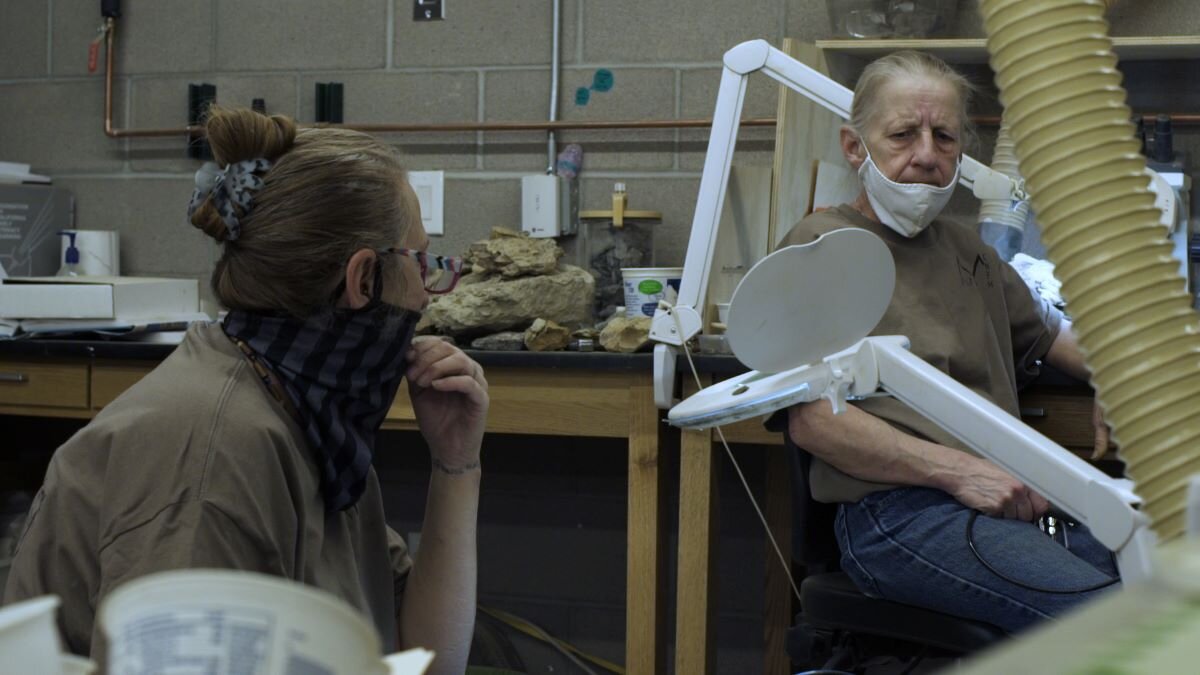Discovering fossilized dinosaur skin gave Sue Mock a new lease on life

CRAIG, Colo. — With a vacuum system roaring and die grinders whirring, Sue Mock holds a small rock with warts all over it.
“They can't get rid of me,” she said, “I'm here, and I just love what I do.”
The lumpy rock in Mock’s hand is a perfectly fossilized skin impression of a 74-million-year-old dinosaur from the hadrosaur (duck-billed dinosaur) family.
“As soon as I petted Walter’s skin,” Mock said, she was hooked.
Yes, Walter is the dinosaur. He's named after the furry friend who found him. Mock was on a hike with her husband, Ellis Ellis (first and last name) when their dog, Walter, noticed something fairly unusual: bones literally sticking out of a cliff wall.
It's hard not to imagine Walter proudly returning with a dinosaur bone in his mouth. Of course, it didn’t happen quite that way. Nonetheless, the dinosaur would be named after Walter.
Colorado Northwestern Community College (CNCC) houses the Colorado Northwestern Field Museum as a direct result of the discovery of Walter.
Life before Walter
Mock is now the repository manager of the Field Museum, something she wouldn’t have imagined eight years ago.
While Walter was being unearthed, Mock herself was in Michigan battling cancer.
Mock recalled, “When you go through a battle of cancer, you think … 'what are my values? Where do I need to go?' And one of the things was: I want to go to Colorado.”
Mock sold almost everything she owned, including her car. She picked a point on the map: Craig, Colorado and then packed up the cats, booked a train ticket to La Junta, and from there, a bus to Craig. She picked up a job at Walmart and settled into her new life. She hadn’t met Walter, yet.
In 2015, the Bureau of Land Management allowed the field museum to become a curatorial fossil repository. This means bones found in northwest Colorado can stay put. With this distinction, a collection formed, and the outside world was invited to look at it. Mock wanted to go.
“When I actually came down to the repository, Liz, the paleontologist, let me touch [Walter’s] skin. And then I was like, ‘How do I get here?’” Mock remembers.
The answer? Go to school.
So that’s what Mock did.
Walter creates a unique opportunity
When one bone after another was excavated revealing an excellent specimen, the college had some big decisions to make. They could hand over the whole project to a bigger institution. They could run it themselves but would have to turn the finds over to an approved repository. Or, they could go through the many hurdles to become a federally approved repository. They courageously chose the third option.
Creating a repository would require numerous tools, vacuum systems, and storage. All of this was purchased with the help of local partners and grants.
Managing the dig for Walter and creating a legal means of keeping the fossils on campus created an incredible and rare opportunity for community college students, said Liz Johnson, curator of paleontology and a science instructor at CNCC. “Everything we do cycles back to how to get our students involved,” Johnson said.

CNCC is a two-year institution where students can take all the basics: chemistry, biology and more. But on top of that, they offer a hands-on field paleontology program that students normally wouldn’t get until they are at a master’s or Ph.D. level.
“Our students can come out and dig for two weeks and we teach them all they need to know, from geology and mapping to techniques you use out in the field,” Johnson said. “Then they come back and actually prepare the bones in the labs, and they get to see behind-the-scenes museum protocols, procedures, and data tracking.”
To complete the program, students design and create an exhibit display for the museum. These displays are open to the public anytime the college is open.
The last piece of the puzzle
Starting as a volunteer herself, Mock is now a part-time employee overseeing the work of other volunteers. Mock said, “We couldn’t do any of this without our volunteers.”
The kind of work Mock does would drive some people to madness. It’s detailed and meticulous. And the payoff is often long in the future. But, this suits Mock just fine.
“I like to play in the dirt. I like to discover things. I love puzzles,” Mock said. "Walter [is a] giant jigsaw puzzle.”
For Mock, meticulously drilling and cataloging the many pieces of Walter is a perfect vocation; a unique piece of the puzzle of her life – created, like Walter’s, by the accumulation of external forces, internal pressure, and the ebb and flow of time.
“I’ve found my home. I’ve found my niche in life,” Mock said. “I’ve never been happier than I am now.”
Visit the Colorado Northwestern Field Museum at the Colorado Northwestern Community College, Craig campus. The museum is open every weekend 10:00 AM-2:00 PM. You can learn more at friendsofnaturalhistorynorthwestcolorado.com.
Cullen Purser is a multimedia journalist at Rocky Mountain PBS. You can reach him at cullenpurser@rmpbs.org.